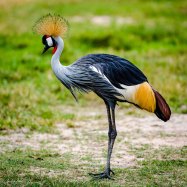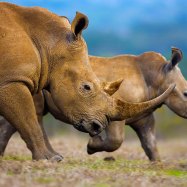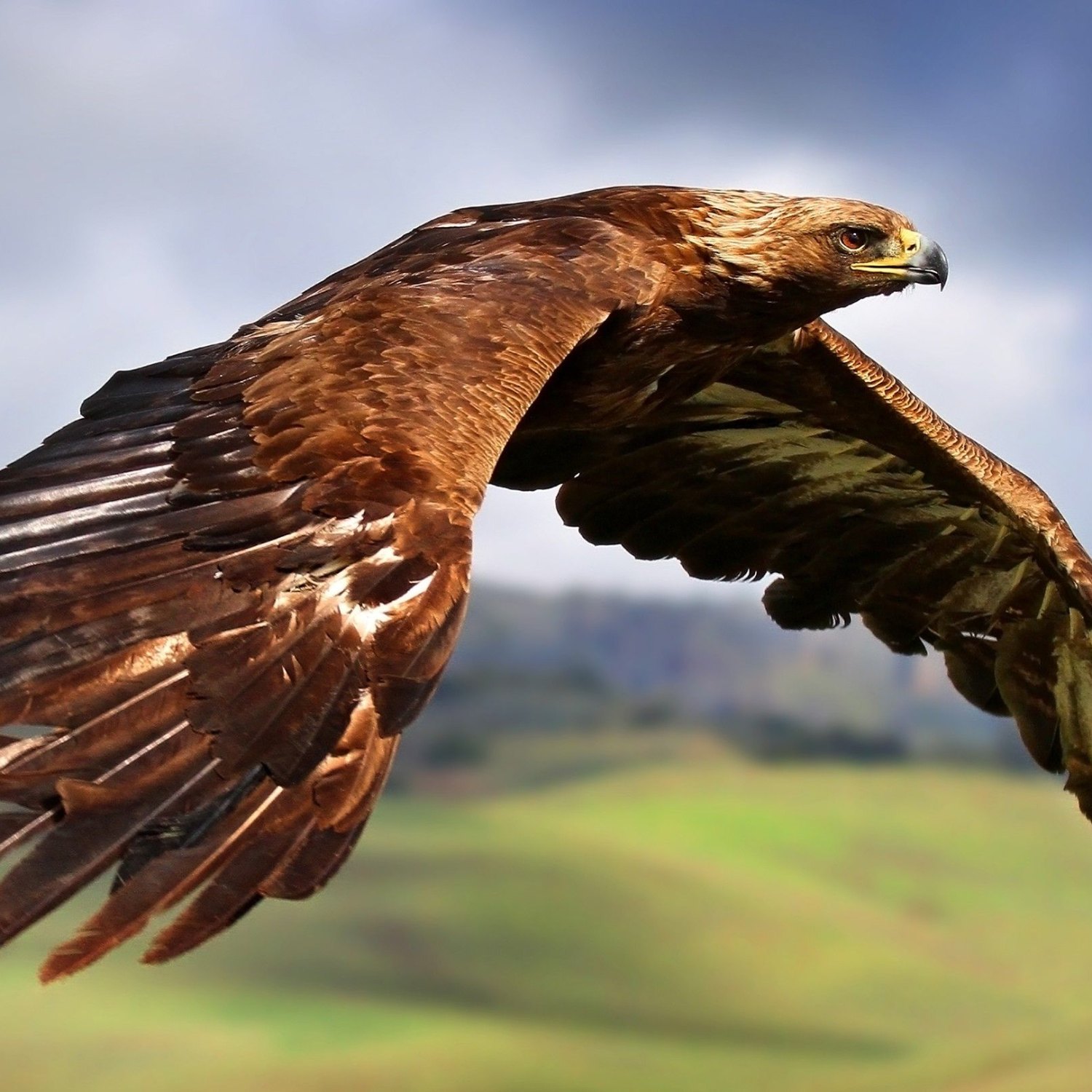
Golden Eagle
2.3 - 3 feet
The Golden Eagle, a large and powerful bird of prey, can be found in a wide range of habitats. With a length of 2.3-3 feet and a wingspan of up to 7 feet, it belongs to the Accipitridae family. With its sharp talons and keen eyesight, it is a skilled hunter and an important part of its ecosystem. #GoldenEagle #Birds #Wildlife #Accipitridae
Animal Details Summary:
Common Name: Golden Eagle
Kingdom: Animalia
Habitat: Open areas, mountains, forests, tundra
The Mighty Golden Eagle: A Master of the Skies
The Golden Eagle, also known by its scientific name Aquila chrysaetos, is a majestic bird of prey that roams the skies of various continents in an impressive display of power and agility. This magnificent creature belongs to the Animalia kingdom, the Chordata phylum, and the Aves class. It is a member of the Accipitriformes order and the Accipitridae family. With its wide distribution, ranging across North America, Europe, Asia, and Africa, this bird is a true symbol of strength and resilience Golden Eagle. In this article, we will delve into the fascinating world of the Golden Eagle and discover what makes it such an iconic and revered animal.Habitat and Distribution
The Golden Eagle is a versatile species that can thrive in various habitats, such as open areas, mountains, forests, and tundra. It has a wide geographical distribution, with a presence in multiple countries globally. This includes the United States, Canada, Mexico, Russia, Kazakhstan, Mongolia, and many others. Due to its adaptable nature, this eagle species can also be found in diverse locations, ranging from sea level to high elevations of up to 13,000 feet. This makes it one of the most widespread and successful birds of prey in the world.Appearance and Physical Characteristics
One of the most striking features of the Golden Eagle is its coloration. Its name derives from the distinctive golden-brown plumage that adorns its head and neck. The rest of its body is covered in various shades of brown, creating a beautiful and regal appearance Gnat. As a large bird, the Golden Eagle has a powerful and imposing body shape, with a wingspan that can reach up to 7 feet. It measures between 2.3 to 3 feet in length and can weigh anywhere between 6 to 15 pounds, depending on its gender and age.Behavior and Hunting Techniques
The Golden Eagle is a fierce and agile predator, with keen instincts and impressive hunting skills. Its diet consists mainly of small to medium-sized mammals, such as rabbits, hares, squirrels, and even small deer. It is also known to capture larger prey, including foxes and young goats, using its sharp talons and powerful beak. This eagle species is a true carnivore, and it uses its incredible speed and agility to catch its prey.Golden Eagles are solitary creatures and are known to fiercely defend their territory, which can span up to 60 square miles. They use their sharp vision to spot potential prey from high in the sky and then swoop down to catch it with incredible speed and precision. These birds can fly at high altitudes, reaching speeds of up to 150 miles per hour, making them one of the fastest birds in the world.
Cultural Significance
The Golden Eagle has been a significant symbol in various cultures throughout history, especially in North America. Many Native American tribes revered this bird, considering it a messenger of the gods and a symbol of courage, freedom, and power. Some tribes even used Golden Eagle feathers in their traditional ceremonies and regalia. Today, this bird remains an important cultural symbol, with many organizations dedicated to its conservation.As a top predator, the Golden Eagle plays a vital role in maintaining the balance of ecosystems. Its presence in many habitats also serves as an indicator of a healthy and thriving environment. Sadly, these majestic creatures are facing numerous threats, including habitat destruction, pollution, and illegal hunting. It is crucial to protect and preserve their natural habitats to ensure their survival and the well-being of our planet.
Threats and Conservation Efforts
The Golden Eagle is listed as a species of least concern on the International Union for Conservation of Nature (IUCN) Red List, meaning its population is stable at the moment. However, this does not mean that it is not facing any threats. Human activities, such as habitat destruction and illegal hunting, still pose a significant danger to these birds. In some areas, they are also facing competition for prey from other predators, such as foxes and wolves.To protect and conserve this magnificent bird, numerous efforts have been made by conservation organizations and governments. These include creating protected areas and enforcing strict laws against hunting and habitat destruction. There are also ongoing initiatives to monitor and track Golden Eagle populations to gather more information and develop effective conservation strategies.
The Future of the Golden Eagle
The Golden Eagle has managed to survive and thrive for thousands of years, adapting to various environments and overcoming numerous challenges. However, as human activities continue to have a significant impact on the natural world, the future of this species remains uncertain. It is our responsibility to take care of our planet and ensure the survival of all living creatures, including the Golden Eagle.Through education, conservation efforts, and sustainable practices, we can ensure a better future for these magnificent birds and the ecosystems they inhabit. As individuals, we can also make a difference by supporting conservation organizations and advocating for the protection of their habitats.
The Golden Eagle: A Living Symbol of Power and Grace
In conclusion, the Golden Eagle is a true marvel of nature, with its impressive physical characteristics, hunting abilities, and cultural significance. It is a powerful and adaptable predator, representing strength, resilience, and freedom. As we continue to learn more about these birds and work towards their conservation, we can ensure that the symbol of the Golden Eagle will continue to soar high in the sky for generations to come. Let us appreciate and protect this magnificent creature, a true master of the skies.

Golden Eagle
Animal Details Golden Eagle - Scientific Name: Aquila chrysaetos
- Category: Animals G
- Scientific Name: Aquila chrysaetos
- Common Name: Golden Eagle
- Kingdom: Animalia
- Phylum: Chordata
- Class: Aves
- Order: Accipitriformes
- Family: Accipitridae
- Habitat: Open areas, mountains, forests, tundra
- Feeding Method: Carnivorous
- Geographical Distribution: North America, Europe, Asia, Africa
- Country of Origin: Various countries
- Location: Wide range of habitats across its distribution
- Animal Coloration: Brown with golden-brown plumage on head and neck
- Body Shape: Large and powerful with a wingspan up to 7 feet
- Length: 2.3 - 3 feet
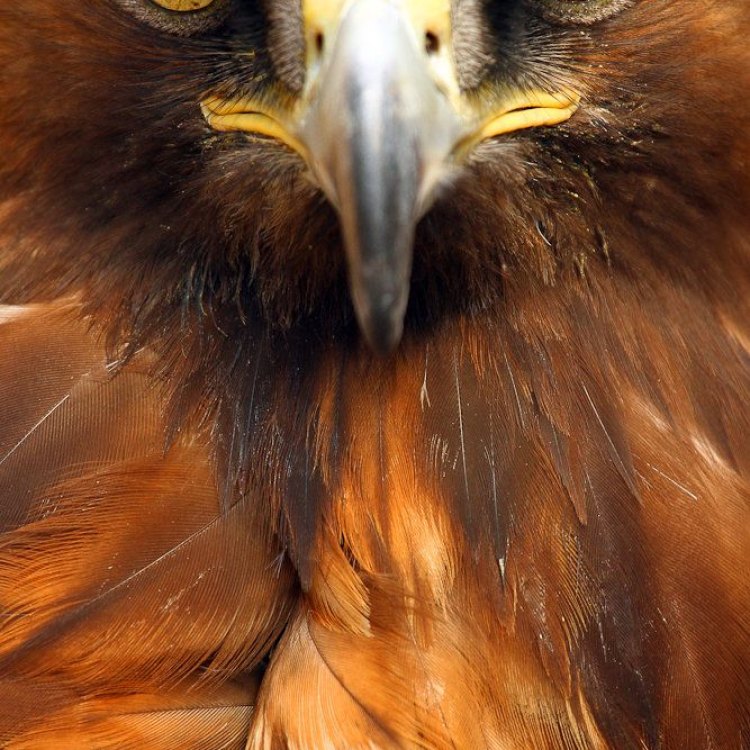
Golden Eagle
- Adult Size: Wingspan up to 7 feet, weight 7 - 15 pounds
- Average Lifespan: Up to 30 years in the wild
- Reproduction: Sexual
- Reproductive Behavior: Monogamous
- Sound or Call: High-pitched screams and whistles
- Migration Pattern: Migratory
- Social Groups: Solitary or in pairs
- Behavior: Highly territorial and defensive of their nesting sites
- Threats: Habitat loss, illegal hunting, and pesticide contamination
- Conservation Status: Least Concern
- Impact on Ecosystem: Apex predator
- Human Use: Used in falconry
- Distinctive Features: Large size, sharp beak, golden-brown plumage on head and neck
- Interesting Facts: Golden eagles are agile flyers and are known for their impressive hunting skills.
- Predator: Mountain lions, wolves, and occasionally other large predators
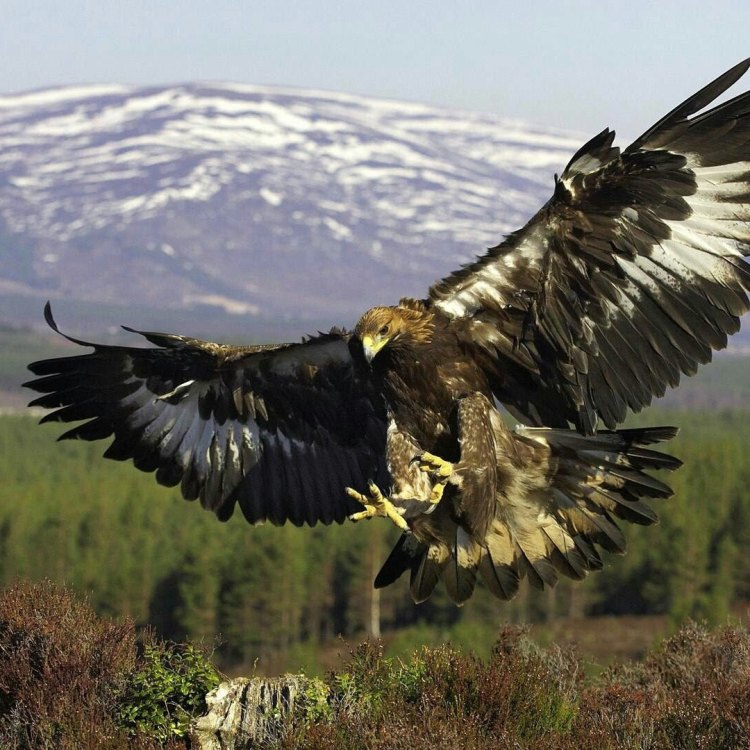
Aquila chrysaetos
The Majestic Golden Eagle: A Predatory Wonder
The vast landscapes of North America are home to many spectacular species, but perhaps none are as majestic and powerful as the golden eagle. These birds of prey are true icons of the wild, with their impressive size, fierce hunting abilities, and distinctive golden-brown plumage earning them a special place in our imaginations.But beyond their symbolic significance, golden eagles are also crucial players in their ecosystems, acting as apex predators and maintaining balance in the food chain. In this article, we will dive deeper into the fascinating world of golden eagles, exploring their unique features, behavior, and impact on the environment PeaceOfAnimals.Com.
The Anatomy of a Predator
The golden eagle, or Aquila chrysaetos, is one of the largest birds of prey in North America. With a wingspan of up to 7 feet and a weight ranging from 7 to 15 pounds, these birds are truly impressive in size. Females are usually larger and heavier than males, as is typical in most raptor species.In terms of lifespan, golden eagles have been known to live up to 30 years in the wild, but the average is closer to 20 years. This longevity is due in part to their monogamous reproductive behavior, in which they mate for life with a single partner.
One of the most recognizable features of the golden eagle is its sharp, hooked beak, which is used for tearing apart their prey. And speaking of prey, these birds are opportunistic hunters, preying on a wide range of animals such as rabbits, hares, squirrels, and even other birds.
Aside from their impressive hunting abilities, golden eagles are also known for their distinct call. They communicate through high-pitched screams and whistles, which can often be heard echoing through the mountains and valleys where they live Goose.
A Symbol of Strength and Beauty
Golden eagles are highly territorial and can commonly be found nesting on cliffs or in the tops of tall trees. They are known to fiercely defend their nests and will attack any potential threats, including humans.Their nesting sites are essential to their reproductive success, as these birds only lay a small clutch of eggs (usually 1 to 2) each year. Both parents take turns incubating the eggs and caring for the hatchlings, which are born helpless and rely on their parents for food and protection.
But beyond the biological and behavioral aspects, the golden eagle holds a special place in many cultures around the world. These regal birds have been revered and revered as symbols of strength, courage, and freedom by various indigenous communities.
In Native American culture, for example, the golden eagle is considered a spiritual guide and messenger, representing the power of the sun and the connection to the spiritual realm. In ancient Roman and Persian cultures, these birds were associated with the gods and were used as symbols of power and authority.
A Relentless Hunter
Golden eagles are not only a symbol of strength and beauty but also of fierce and efficient hunting skills. These birds are agile flyers and can reach speeds of up to 150 miles per hour when diving for prey. They have incredible eyesight, with the ability to spot their next meal from miles away.Their hunting techniques are also impressive and varied. They use a combination of speed, stealth, and surprise to catch their prey. Their powerful talons, with sharp and curved claws, are used to grab and kill their targets, while their sharp beaks are used to dismember the prey.
Golden eagles are also opportunistic and have been known to scavenge on carrion, making them an important part of the ecosystem's clean-up crew.
Guardians of the Wilderness
As apex predators, golden eagles play a crucial role in maintaining balance in their ecosystems. They help control the populations of their prey, preventing them from overeating and damaging their habitats.But beyond their direct impact, golden eagles also have a ripple effect on the environment. A decline in their populations could lead to an imbalance in the food chain, affecting other species and potentially disrupting the entire ecosystem.
Unfortunately, golden eagles face many threats, both natural and human-made. Habitat loss, through deforestation and urbanization, is a major concern, as it reduces the available nesting sites and prey for these birds.
Illegal hunting and trapping also pose a significant threat to golden eagles, as they are often targeted for their feathers and other body parts that are used in traditional medicine and cultural practices. Additionally, pesticide contamination can also affect these birds, as they can accumulate toxins through their prey and suffer adverse effects.
Conservation Efforts and Human Use
Thankfully, golden eagles are listed as least concern on the IUCN Red List, with an estimated global population of around 300,000 individuals. However, continued conservation efforts are still necessary to ensure their long-term survival.Several organizations and governments have implemented measures to protect golden eagle populations, such as establishing protected areas where these birds can safely nest and hunt. Education and awareness campaigns are also crucial in reducing illegal hunting and promoting responsible behavior towards these birds.
While golden eagles are predominantly wild animals, they have also been used in falconry for thousands of years. This ancient practice involves training them to hunt for food alongside humans, and it continues to be an important cultural tradition in many countries.
However, strict regulations and licensing are in place to ensure the welfare and conservation of these birds. Falconers must undergo extensive training before they can work with golden eagles, and the birds must be well-cared for and kept in suitable conditions.
Fascinating Creatures: Fun Facts about Golden Eagles
Golden eagles are not only impressive predators; they also have many interesting characteristics and behaviors that make them truly fascinating creatures. Here are some fun facts you may not have known about golden eagles:- Golden eagles have excellent eyesight, with a visual acuity of 20/5 or possibly even 20/4. This means that they can see objects at 20 feet that a person with normal eyesight can only see at 5 or 4 feet, respectively.
- These birds have a unique way of clearing their nasal passages. They tilt their head back and sneeze forcefully, expelling mucus and any debris that may be blocking their nostrils.
- Golden eagles are not picky eaters and can prey on animals as small as insects or as large as a deer.
- They are also known for their impressive aerial acrobatics, with the ability to fly upside down and even perform somersaults.
- In some cultures, the golden eagle is considered a "change-bringer," believed to bring good luck and prosperity to those who spot them in the wild.
A Natural Balance in the Wild
In nature, everything is connected, and each species plays a vital role in maintaining a healthy and functioning ecosystem. Golden eagles are a prime example of this delicate balance, as they not only symbolize strength and beauty but also act as guardians of the wilderness.Through their impressive hunting skills and key position in the food chain, golden eagles help ensure that prey populations do not become too large and out of control. Their presence also signals the health of the environment they inhabit, making them an important indicator species.
As humans, it is our responsibility to recognize the value of these creatures and take actions to protect and preserve them for future generations. Whether through conservation efforts or simply admiring their beauty in the sky, let us continue to appreciate the majestic golden eagle and all it represents.
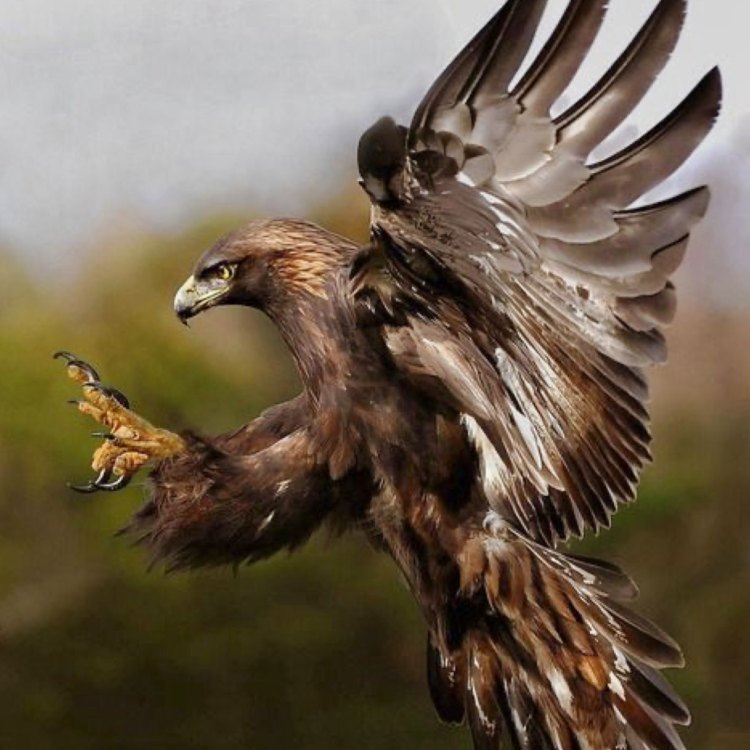
The Mighty Golden Eagle: A Master of the Skies
Disclaimer: The content provided is for informational purposes only. We cannot guarantee the accuracy of the information on this page 100%. All information provided here may change without prior notice.







